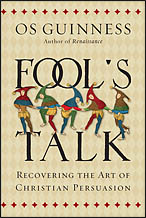In his excellent book Fool’s Talk: Recovering the Art of Christian Persuasion (2015), eminent evangelical sociologist, social critic and apologist Os Guinness insightfully describes Christian apologetics as being both ‘the way of the closed fist’ and ‘the way of the open hand’:
In the earlier days of the Church there were two symbols for the art of Christian advocay, which had come down from ancient practices in law and rhetoric.
One was a closed fist. The represented the dissuasoria, the negative side of apologetics that used all the higher strengths of human reason in defense of truth. Mustering all the power of reasons, logic, evidence and argument, closed-fist apologetics had the task of answering every question, countering every objection, and dismantling false objections to the faith and to knowing God. In the words of St. Paul: ‘We are destroying speculations and every lofty thing raised up against the knowledge of God, and we are taking every thought captive to the obedience of Christ» (2 Cor 10:5).
The other symbol was the open hand. This represented the persuasoria, the positive side of apologetics that used all the highest strengths of human creativity in the defense of truth. Expressing the love and compassion of Jesus, and using eloquence, creativity, imagination, humor and irony, open-hand apologetics had the task of helping to pry open hearts and minds that, for a thousand reasons, had long grown resistant to God’s great grace, so that it could shine like the sun.
Today, as then, both approaches to Christian advocacy are necessary, and both are fruitful. We may each be better at one than the other, but we must never make the mistake of finally choosing one over the other. They are both essential parts of persuasion. But is there any doubt that the one we must need to recover today, both to be true to our Lord and to gain the key to reach the hearts and minds of our post-Christian generation, is the way of the heart of love that reaches out to persuade with an open hand? (pp. 253-254)
For some historical background information on these two symbols, see the following article:
- Edward P. J. Corbett: «The Rhetoric of the Open Hand and the Rhetoric of the Closed Fist«
(Picture from ThoughtCo.com. Updated 31st August 2017.)

